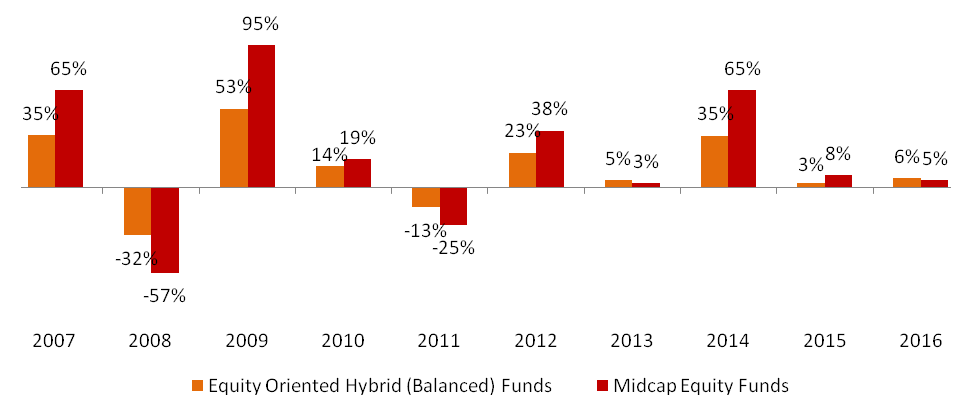Balanced Funds Demystified: Part 1

Historically, mutual funds in India constitute a very small percentage of average household savings. But in the last 5 years or so, the popularity of mutual funds among retail investors in India has increased substantially. While mutual funds are still a relatively small percentage of household savings in our country compared to the developed economies, it is encouraging to see mutual fund industry assets under management (AUM) growing almost three times (as per AMFI data) in the last 5 years. One particular mutual fund category that has seen phenomenal growth in the last 5 years is Balanced Funds; balanced funds AUM (as per AMFI) has grown more than 8.5 times in the last 5 years.
The spectacular growth in Balanced Mutual Funds AUM is understandable. More and more new investors across India, especially from smaller cities and towns, want to invest in mutual funds now. Balanced Funds are thought to be ideal investment options for new investors, because new investors are likely to have lower risk appetites and the risk profile of Balanced Funds is less aggressive than Equity Funds. Many Asset Management Companies (AMCs) are also aggressively pushing Balanced Funds as the stock market continues to make new highs and there are concerns about valuations. It is therefore, natural that balanced funds are the most favored investment recommendations of mutual fund distributors or financial advisors for new investors and investors with lower risk appetites.
While Balanced Mutual Funds are excellent investment choices for asset allocation and risk limitation, I have observed that there are several misconceptions regarding Balanced Mutual Funds among investors. These misconceptions are primarily a result of how Balanced Mutual Funds are being sold by financial advisors. Financial advisors try to simplify investments for retail investors because most investors do not have sufficient knowledge of markets and investments. But the zeal for simplification often leads to over-simplification which can be counter productive to the investor’s interests. In this 2 part blog post, we will try to explain what Balanced Mutual Funds are, how they work and clarify some common misconceptions about Balanced Mutual Funds.
Balanced Mutual Funds are hybrid funds which invest in both equity and debt assets. Balanced Funds can be either equity oriented or debt oriented, depending on the asset allocations. The asset allocation of a particular Balanced Mutual Fund is not fixed. It can vary within a certain range specified in the scheme information document of the fund. Balanced Mutual Funds can be taxed either as an equity fund or a debt fund. Let us now clarify some common misconceptions regarding Balanced Mutual Funds.
Balanced Funds are not Balanced
By balanced we usually mean equal weights on either side. In the context of investments, investors may think Balanced Funds have similar allocations to debt and equity. In reality Balanced Funds are heavily weighted towards equity or debt, depending on the type of the fund.
For example, Equity Oriented Balanced Funds have at least 65% exposure to equity and a maximum 35% allocation to debt. Equity exposure of Equity Oriented Balanced Funds can be as high as 75%; as per November 2017 factsheets of a number of popular Balanced Funds, the equity allocation is now in the range of 72 to 75%. Surely, this asset allocation cannot be called balanced. Investors should clearly understand the asset allocation and risk profile of Balanced Funds, and not simply go by the scheme name or what their financial advisor may have to say about the fund. In Advisorkhoj, we always encourage investors to educate themselves and do their own homework before investing.
Risk of different Balanced Funds can vary widely
In my opinion, one of the biggest issues in the mutual fund industry in India is the lack of standardization in product nomenclatures and descriptions. For example, an AMC can call a mutual fund scheme, which invests only in midcap or small cap stocks, a diversified equity fund. Sometimes a mutual fund scheme which invests in a particular theme can also be called a diversified equity funds. There is also no standardization of product categories across different research websites – each website has its own scheme categorization terminology and methodology. This can be very confusing for average retail investors.
The term Balanced Fund is often applied to different types of products with different asset allocation profiles. The most common usage of Balanced Mutual Fund as a product category refers to Equity Oriented Balanced Funds. These funds have at least 65% asset allocation to equity and remaining allocation to debt. However, the term Balanced Fund can also be used for products with different asset allocation. For example, a Debt Oriented Balanced Fund can have 5% to 25% allocation to equity and 75% to 95% to debt. Naturally, the risk characteristics of such funds are very different from Equity Oriented Balanced Funds.
In Advisorkhoj.com research, we prefer to use the term Hybrid Fund instead of Balanced Fund. We think Hybrid Fund is a more suitable name because it simply suggests that the fund has hybrid asset allocation and there are no implicit suggestions about risk characteristics (as discussed earlier Balanced Funds are not really Balanced Fund). There are broadly different types of Hybrid Funds:-
Equity Oriented Hybrid Funds:
As mentioned earlier, these funds have at least 65% allocation to equity and the remaining to debt. The asset allocation can vary within a range (e.g. 65% - 75% for equity) at the fund manager’s discretion or based on some methodology (Price to Earnings, Price to Book etc.). If the fund manager will increase the equity exposure to higher end of the asset allocation range if he or she is bullish on equity and reduce the equity exposure to lower end of the asset allocation range if he or she is bearish on equity. Balanced Funds which follow valuation based asset allocation may reduce equity exposure with valuations (P/E or P/B) are high and vice versa.
The asset allocation strategy notwithstanding, with 65% to 75% asset allocation to equity, the risk profile of these funds is usually moderately aggressive. However, some equity oriented hybrid funds may have more moderate risk profiles depending on active equity exposure (we will discuss in more details later). These funds are taxed like Equity Funds. Short term capital gains (investment held for less than 1 year) are taxed at 15% plus Cess. Long term capital gains (investment held for more than 1 year) are tax free. Dividends paid by Equity Oriented Hybrid Funds are tax free. As discussed earlier, in mutual fund industry parlance, these funds are called Balanced Funds.Debt Oriented Hybrid Funds:
These funds have majority allocation (more than 50%) to debt and smaller allocation to equities. There are broadly two types of Debt Oriented Hybrid Funds. The aggressive debt oriented hybrid funds have around 25% allocations to equity; equity allocation can be increased even further, subject to an upper limit (e.g. 30%) at the fund manager’s discretion. The conservative debt oriented hybrid funds have only around 5% allocation to equity. Risk in Debt Oriented Hybrid Fund is much lower compared to Equity Oriented Hybrid Funds; potential returns from Debt Oriented Hybrid Fund over a long investment horizon will also be lower than Equity Oriented Hybrid Funds.
Investors should note that, Debt Oriented Hybrid funds are taxed like debt funds. Capital gains in debt funds for investments held for a period of less than 3 years are taxed as per the income tax slab of the investor. Capital gains in debt funds for investments held for a period of more than 3 years are taxed at 20% after allowing for indexation benefits. Though dividends paid by Debt Oriented Hybrid Funds are tax free in the hands of the investors, the AMC has to pay dividend distribution tax (DDT) at the rate of 28.84%before paying out dividends to investors.
In the last 5 years Equity Oriented Hybrid Funds as a category has given average 14.6% compounded annual returns, while Debt Oriented Hybrid Funds as a category has given 9.6% compounded annual returns (as per Advisorkhoj.com Research). In the stock market crash of 2015, though Equity Oriented Hybrid Funds (Balanced Funds) gave positive returns, the average category return was only 3.2%, which was lower than the risk free interest rates. In the same year, Debt Oriented Hybrid Funds on average gave 5.6% returns (as per Advisorkhoj.com Research). You can see that the risk return characteristics of these two types of Hybrid Funds are therefore very different.
Balanced Funds are not safe
Investors should know that, Balanced Funds (especially Equity Oriented) are not safe investments. In investment parlance, the term safe can have different connotations for different investors. For some investors, the term safe means no risk of loss while for others it is more subjective and can imply limited losses. Investors should know that, any investment which has a significant equity component cannot be safe. Balanced funds can make losses in bear markets, however the losses will be limited compared to purely equity funds.
The chart below shows the average annual returns of Equity Oriented Hybrid Funds (Balanced Funds) versus one of the riskiest fund category i.e. midcap funds over the last 10 years.

Source: Advisorkhoj Research
Observe that Balanced Funds gave -32%, -13% and 3% (lower than risk free rate) returns in 2008, 2011 and 2015 respectively. In bear markets you should be prepared to see losses in your Balanced Funds. Balanced Funds are by no means safe, but as you can see in the chart above, the losses in bad years are significantly lower from those in midcap funds. In good years, Balanced Funds gave good returns, often exceeding even 20%, though lower than equity fund returns. Let us now compare the average annual returns of Equity Oriented Hybrid Funds (Balanced Funds) versus the Debt Oriented Hybrid Funds midcap funds over the last 10 years.

You can see that, Debt Oriented Hybrid Funds on average gave negative returns only in 2008. In 2011 returns were positive, but lower than risk free rate. In other years, Debt Oriented Hybrid Funds gave more than risk free returns. Comparing the returns of Equity Oriented and Debt Oriented Hybrid Funds in different market conditions we can infer that, Debt Oriented Hybrid Funds have much lower risks compared Equity Oriented Hybrid Funds, but the longer term returns are also lower.
Conclusion
The notion of risk should always be relative and always should go hand in hand with expected returns. You should select between Equity Oriented Hybrid Funds and Debt Oriented Hybrid Funds based on what is more important to you – reducing the risk of losses or getting higher returns. Whether you want regular income or capital appreciation should also be a consideration. Volatility reduces predictability of income and therefore, Debt Oriented Hybrid Funds are more suitable for the purpose of getting regular income, while Equity Oriented Hybrid Funds are suitable for capital appreciation. We will discuss other aspects of Balanced Funds investment in our next post. Stay tuned……
Mutual Fund Investments are subject to market risk, read all scheme related documents carefully.
RECOMMENDED READS
The information being provided under this section 'Investor Education' is for the sole purpose of creating awareness about Mutual Funds and for their understanding, in general. The views being expressed only constitute opinions and therefore cannot be considered as guidelines, recommendations or as a professional guide for the readers. Before making any investments, the readers are advised to seek independent professional advice, verify the contents in order to arrive at an informed investment decision.
Mutual Fund investments are subject to market risks, read all scheme related documents carefully.
Quick Links
Follow Nippon India MF
More About Nippon India MF
POST A QUERY






